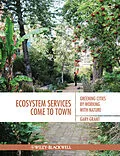The need to find new approaches to the development of cities is
becoming increasingly urgent in this age of continuing population
growth, demographic transition, climate change, fossil fuel peak
and biodiversity losses. Restoring ecosystem services and promoting
biodiversity is essential to sustainable development - even
in the built environment.
Ecosystem Services come to Town: greening cities by working
with nature demonstrates how to make urban environments
greener. It starts by explaining how, by mimicking nature and
deliberately creating habitats to provide ecosystem services,
cities can become more efficient and more pleasant to live
in. The history of cities and city planning is covered with
the impacts of industrial urban development described, as well as
the contemporary concerns of biodiversity loss, peak oil and
climate change.
The later sections offer solutions to the challenges of
sustainable urban development by describing and explaining a whole
range of approaches and interventions, beginning at the regional
scale with strategic green infrastructure, looking at districts and
precincts, with trees, parks and rain gardens and ending with
single buildings, including with green roofs and living walls.
Technical enough to be valuable to practitioners but still
readable and inspirational, this guide demonstrates to town
planners, urban designers, architects, engineers, landscape
architects how to make cities more liveable.
Autorentext
Gary Grant is a Chartered Environmentalist, Member of the Institute of Ecology and Environmental Management, an Academician at the Academy of Urbanism, Member of the All Party Parliamentary Committee on Biodiversity, thesis supervisor at the Bartlett Faculty of the Built Environment, University College London, Chair of the Judges of the Integrated Habitats Design Competition and Director of the Green Roof Consultancy Ltd. As director of EDAW and then AECOM Design + Planning and now independent, he has worked on large scale planning projects including the London 2012 Olympic Park, the Bedford Valley River Park, the Whitehill-Bordon Eco Town, Education City, Qatar and Saadiyat Island, Abu Dhabi.
Klappentext
The need to find new approaches to the development of cities is becoming increasingly urgent in this age of continuing population growth, demographic transition, climate change, fossil fuel peak and biodiversity losses. Restoring ecosystem services and promoting biodiversity is essential to sustainable development even in the built environment.
Ecosystem Services come to Town: greening cities by working with nature demonstrates how to make urban environments greener. It starts by explaining how, by mimicking nature and deliberately creating habitats to provide ecosystem services, cities can become more efficient and more pleasant to live in. The history of cities and city planning is covered with the impacts of industrial urban development described, as well as the contemporary concerns of biodiversity loss, peak oil and climate change.
The later sections offer solutions to the challenges of sustainable urban development by describing and explaining a whole range of approaches and interventions, beginning at the regional scale with strategic green infrastructure, looking at districts and precincts, with trees, parks and rain gardens and ending with single buildings, including with green roofs and living walls.
Technical enough to be valuable to practitioners but still readable and inspirational, this guide demonstrates to town planners, urban designers, architects, engineers and landscape architects how to make cities more liveable.
Inhalt
About the Author xi
Acknowledgement xiii
1. Introduction 1
Modern Cities and the Disconnected 1
Population Spike 2
Limits to Growth 3
Global Threats 3
Ecosystem Services and Stewardship 4
Greening Cities is Necessary 5
Hope 5
2. Origins of Cities 7
Why Look Back? 7
Emergence of the Human Species 7
Great Leap Forward 8
Agriculture and Permanent Settlements 8
Agriculture Around the World 10
Agriculture Intensifies 11
Empires Rise and Fall in Mesopotamia 12
Nile Valley 12
Indus Valley 13
Ancient China 13
Ancient Greece 14
On the Ganges 15
Rome 16
The Moche 16
Mesoamerica 17
Fortified Centres of Administration 17
European Renaissance 18
Early Modern 19
Squalor 21
3. Modern Cities 23
Origins of the Modern City 23
Industrial Revolution 23
Railways 24
Rapid Growth 25
Ill Health 26
Distinctive New Districts Emerge 27
Paris Re-born 28
Railways and Suburbs 29
Planning and Zoning 29
Garden Cities 29
Motor Vehicles Herald in the Oil Age 31
A Humane Outlook 32
Going Up 33
Continued Rise of the Motor Vehicle 33
Decline of the Inner City 34
New Towns 35
City Plans 36
An Unfinished Task 37
4. Issues Facing Contemporary Cities 39
Impacts of Cities and City Living 39
Habitat Loss 40
Habitat Fragmentation 41
Impacts on Soil 41
The Water Cycle 42
Water-borne Pollution 44
Urban Heat Islands 44
Air Pollution 45
Noise 46
Light Pollution 47
Agricultural Land Take 47
Concrete 48
Steel 48
Glass 49
Timber 49
Waste 49
Drivers of Population Growth 50
Peak Oil 52
Peak Phosphorus 52
Post Oil 53
5. Working with Nature 55
Ecology and Ecosystems 55
Born Free 56
Saving the Great Lakes 56
Earth Summit, Ecosystem Assessment and Ecosystem Services 58
Cities as Part of the Biosphere 59
Ecological Restoration 59
Urban Wildlife 60
Green Infrastructure 60
Sustainable Sites Initiative 61
Advice from Professional Bodies and Others 61
Mimic Nature 62
Working with Nature Works 63
6. Urban Nature 65
Open Space Preservation 65
The Naturalists 66
Nature Leaves the City? 66
Urban Nature Returns 68
Wildlife Gardens 69
Encapsulated Countryside 70
Bukit Timah 71
The Urban Forest 72
Urban Wastelands 73
Canvey Wick 74
Emscher Park 75
Urban Farming 76
Biodiversity Action Plans 77
River Corridors 78
London's South Bank 79
Minneapolis Riverfront 79
7. Water and Cities 81
Fresh Clean Water Essential and Increasingly Scarce 81
Civilisation has Modified the Water Cycle 82
Water Consumption 82
Embodied Carbon 82
Virtual Water 83
Catchment Management 84
Rainwater Harvesting 84
Grey Water 85
Sustainable Urban Drainage 85
Water Sensitive Urban Design 86
Rain Gardens 86
The Streets are Changing 86
Ponds 88
Potsdamer Platz 89
River Restoration 89
Th...
